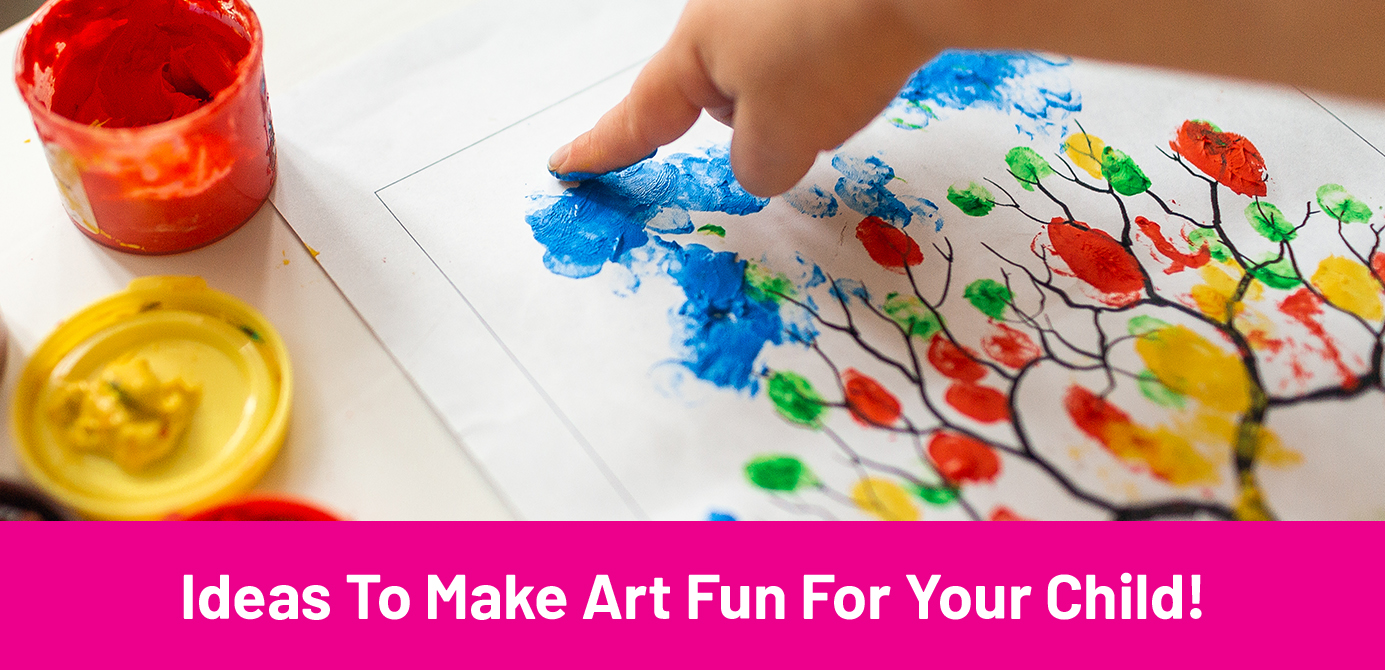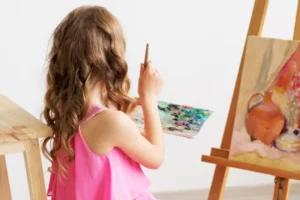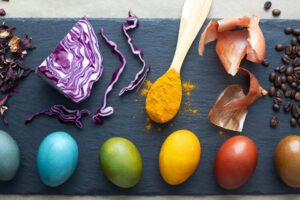Ideas To Make Art Fun For Your Child!
![]()
- Posted by abrakadoodle.com.sg
- Categories Painting ideas for kids
- Date 9 September 2021

Nurture your child’s individuality. Your task as a parent is to put your child on a path that helps move away from being the same as other children. Remember, your child is naturally creative and needs the right stimulus to bring her abilities to life by facilitating exciting experiences through at home art classes. Guiding her imagination gently by doing things that are fun to learn about the world she is growing up in. Developing her creativity, confidence and problem solving skills.
As a parent you will not only help her break free, but begin to see your child as a unique being with her own interests, learning styles and personality. This will also help you bond better, and build a lifelong relationship for lifelong learning experiences.
You will love the art classes and will begin to believe how art can play a big role during your child’s early years. Discovering fun ways to get to know each other.
Table of Contents
ToggleGet started for art time at home

The next time you go to the supermarket, head straight to the shelves where art material is put on display. Pick up a few paint brushes, crayons, oil pastels, watercolour paints, and sheets of watercolour paper for art activities at home.
Once back home, set up your child’s art session on the dining table. Remember to spread a few old newspaper sheets to cover the table. Place a single piece of watercolour paper, along with a couple of paint brushes. Use paper cups and squeeze a few drops of water colours into them. Invite your child to explore these materials in her own way.
The only guidance she may need for art activities to catch on is through making small talk, “Which colour will you choose first?” Painting is fun, absorbing, and liberating – little wonder then why your child will enjoy her art classes so much. Get started,
Learning through process art

Art is intrinsically very valuable. The process is very beneficial to children as it stimulates creativity and helps develops motor skills. The end results will be something you will cherish for a lifetime. And the outcome of art activities will be something to be proud of and shared.
You will love process art because you can really let your child use the material to express whatever she wants, without worrying about achieving a certain outcome.
Your child might want to start by dipping her paint brush and make dots or wavy lines. Or Try out different colours to create a pattern. She might even put water colours on her fingers and start playing. Let her explore both ways.
Process art is based on an idea that the journey of creation is more important than the final product your child creates. More important, art activities is all about experimentation and play. Here are a few super cool and unique art ideas to engage your child. These art activities use all kinds of fun materials like foam and yarn, marker pens, tissue paper, plastic bottle caps and more. Your child is sure to want to do all of them. And why not?
Yarn block printing

Wrap yarn around a rectangular block of foam or a small cardboard box like empty match boxes. These are inexpensive and can be easily discarded after use. You can space the yarn evenly, or allow your child to create her own pattern – crossing the yarn, spacing it out differently anyway she wants.
Let your child explore with a single colour to see what kinds of designs the yarn blocks could make. Abstract designs are fine for a start, then start mixing colours, whatever takes her fancy.
During art classes your child will try out new approaches. Using blue to stamp the sky, adding a yellow sun. Then picking up a crayon to add more details. At the end, your child would have created something none of us could have imagined.
Catch a star

Start by asking your child to wet the entire sheet of water colour paper. Use a dropper to drop watercolours onto the paper. Then squeeze some turquoise, and green to resemble ocean water. Continue until the paper is completely covered with hues of blue.
Then do something that will instantly start making interesting things happen to the blues. Sprinkle salt onto the painted paper. The salt will create a very beautiful effect on the wet paper. Leave the artwork to dry.
While the paint is drying, cut out a largish star from yellow coloured art paper. If your child can handle scissors safely, get her to cut out smaller stars. Or get your child to stick the star on her painting. Frame it, and hang it on the living room wall.
Fun with India ink & tempera resist

Start by drawing a simple ocean scene on your paper using a pencil. Sketch some fish and seaweed. The more details and areas the better. If your child is very young, get her to watch you do it for her.
Use thick tempera paint (you can make tempera thicker by using more powder and adding water drop by drop until it turns into a thick paste). Paint around the fish and seaweed first. Then paint your fish and seaweed using India ink. Be very careful, India ink stains everything it touches. Leave them to dry thoroughly.
Now comes the tricky part. Once the ink is completely dry, it’s time to rinse your painting under running water. Gently rub off the tempera paint. The waterproof India ink will not wash away and will remain in place.
Once tempera paint is rinsed off, let the paper dry. Add some blue as finishing touches to complete your ocean.
Both you and your child will truly enjoy this technique to create marvellous silhouette of fish and seaweed against the blue ground. You will love to frame this masterpiece as well!
Using a dropper to create originals

Watercolour art activities are full of fun and mesmerizing to watch. Kids love seeing how the colours mix and bleed together. Using a dropper is a classic art activity for children of all ages — toddler, preschool, and kindergarten.
Watercolours are go-to art material when you’re looking for something quick and easy to set up. Use plastic containers or an ice cube tray to hold you paints. You can make the colours lighter by watering them down or leave them as is for more vibrancy. Remember to use a separate dropper for each colour.
Creating really colourful art using just a dropper is also a fun exercise for tiny hands and great practice for developing fine motor skills. If your child has never used a dropper, it will prove to be a great way to get her to suck watercolours into the dropper and squeeze them out again and again until she gets a hang of it.
So start by using a brush to wet the whole sheet of watercolour paper. Then ask your child to fill her dropper with watercolour, and squeeze out a drop or two onto the wet paper. Watch what happens! While she begins to gain confidence in squeezing using her fingers, both of you will have a blast observing the unique patterns and colours spreading all across the paper. Keep adding more and more colours to create some beautiful art!
Dip & dye napkin art

Shibori is a Japanese process of dip dyeing fabric to create dazzling designs. Adapting this technique using tissue paper also creates spectacular results too. Wait till you try this technique out with your child. The outcome will quite simply blow your minds away!
Show your child how to fold the tissue paper accordion style (it will be another motor skill workout for your child). Once you have folded the paper into a long strip, start folding the edge to form a triangle. Continue folding by turning over the strip, making sure you always are left with a triangle.
Use a rubber band around the edges to keep the folded triangle tissue from opening. Now it is time to dunk the edges into vibrant watercolours. Bear in mind, the amount of watercolours the paper sucks in will determine the overall design. Dipping the tissue for too long will result in a smudged outcome. Waiting for too short a time will make the design seem incomplete. Getting it right is the trick.
Waiting to see the design will be irresistible and patience may not be possible when you are working with a child. The excitement will be too intense. In any case, gently begin unfolding the wet tissue paper to reveal the design.
Rest assured, the design will be so unique that it will take your breath away, every time!
Learn more ideas about art classes at Abrakadoodle. Incorporate them into your child’s art activities and see how quickly she will want to play and have fun through art. Arming your child with watercolours and a paint brush doesn’t just develop her fine motor skills – it also means your fridge door and walls will be covered in a constant stream of her unique artworks. Try not to worry too much, watercolours are easy to clean. But before you clean them up, take a picture of your child with her masterpiece as the ground. It will be a treasure to come back to when she is all grown up!
You may also like

Simple Acrylic Painting Tips For Beginners

Made To Measure, Homemade Paint Recipes

